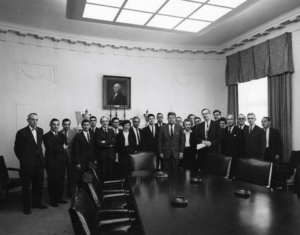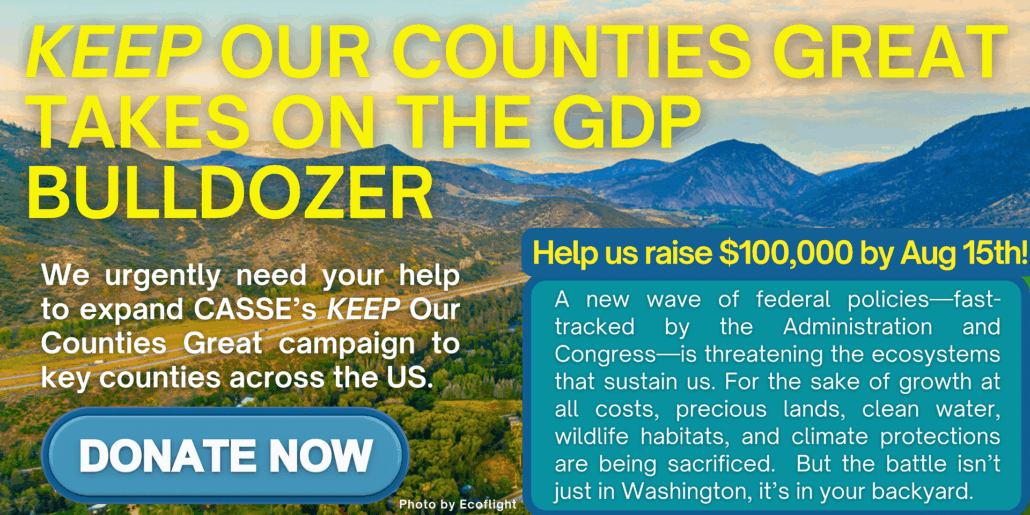Who Tallies the Resources?
by Daniel Wortel-London
The economy of the USA, like that of any other nation, depends on natural resources—minerals, timber, fossil fuels, land, and a host of other renewable and nonrenewable assets. It couldn’t function without these resources any more than you or I could survive without air. So you’d think that determining whether our country’s demand for natural resources exceeds the environment’s supply would be of the greatest importance to politicians.
But you’d be wrong.

Healthy forests provide essential services to the economy. (E. Bryan Crenshaw III, Creative Commons)
In the USA, the federal government does not use any instrument to systematically measure the country’s stocks of natural resources, or our national demand for them. It has no comprehensive method for quantifying whether and to what degree the economy overshoots the environment’s capacity to sustain it.
A Better Way
So we are flying blind into the future, with the most important determinants of our economic prosperity—our jobs and incomes, our productivity and price stability, the competitiveness of our industries and the quality of our investments—at risk because of potential resource depletion or degradation. Already, environmental maladies from climate change to species extinction to water scarcity stand as evidence that heedless economic growth generates side effects that cross vital planetary boundaries, boundaries that seem not to capture the attention of our government.
To place the USA’s economy on a more rational resource footing, CASSE proposes that the Council of Economic Advisors (CEA) be required to include natural capital accounting in its work, which would allow it to analyze trends, programs, and policies related to natural resources. In CASSE’s vision, the CEA would analyze whether the U.S. economy’s use of natural resources falls within the environment’s ability to supply them (either because renewable resources are sustainably regenerated, or because stocks of nonrenewable material are adequate). As one of the chief sources of economic analysis for the president, the CEA is influential in setting the country’s economic direction; its annual report is a good place to set the economy in an environmental context.
We have drafted a bill, the “Economic Footprint Act,” to prescribe this new set of responsibilities for the CEA. With a revised mandate, the CEA can provide the president with the analysis needed to develop a flourishing and resilient economy that operates within boundaries set by nature.
Quantifying Natural Stocks
Most steady staters agree that the boundaries of an economy should be drawn based on nature’s capacity to supply natural resources and assimilate wastes. Transgressing these boundaries leads eventually to economic havoc. For example, overshooting the atmosphere’s capacity to absorb CO2 emissions generates feedback effects that reduce. And this doesn’t begin to account for other examples of economic overextension that produce crises like a mass extinction and “peak-everything.”
A growing number of countries are implementing natural capital accounting measures to determine whether, how, and their economies violate ecological boundaries and deplete metal and mineral stocks. Numerous resources exist for accomplishing either or both of these goals, including Ecological Footprint analysis, Planetary Boundaries research, and the DPSIR framework. One of the most widely used approaches, the U.N.-supported System of Environmental-Economic Accounting (SEEA), is currently implemented in over 90 countries. The U.S. government is signing on as well: More than 40 federal agencies are collaborating to produce a National Strategy to Develop Statistics for Environmental-Economic Decisions, and President Biden has signed an executive order for federal agencies to quantify climate-related financial risks.

Are we ecological debtors, or creditors? Natural capital accounting can help answer this. (ahsanjaya)
Unfortunately, most of these initiatives do not fully capture the dynamics essential to maintaining a steady state economy. Few measure whether stocks and flows of natural capital lie within the capacity of national ecosystems to supply, regenerate, and assimilate them, which is vital for assessing the long-term sustainability of our economy. Most do not analyze what drives our economy to overshoot the nation’s biocapacity (hint: the answer is growth). And few of these initiatives, with the notable exception of those that deal with climate change, trace the broader consequences for the economy of overall resource overuse.
Developing instruments that can measure these dynamics is only part of the challenge, however. Such instruments must also be effective, meaning they must provide information at the scale and level of detail relevant to policymaking. Moreover, the information must come from permanent, influential, and trustworthy government entities like cabinet-level departments, rather than from transitory and politicized sources like the partisan and temporary committees often used in Congress.
The Bill
Founded in 1946, the CEA is statutorily obligated to analyze and interpret economic trends in light of national goals around employment and productivity. These goals are now codified in the Full Employment and Balanced Growth Act of 1978. It follows that if eroding natural capital threatens these goals, the CEA is duty bound to analyze this danger by including the state of the USA’s ecological ecological footprint and biocapacity, along with the status of nonrenewable resources, in its reports.

President Kennedy standing with the Council of Economic Advisors (JFK Library)
To accomplish this, we propose that the CEA be required to incorporate into its annual report chapters related to natural resources and biocapacity. We envision a chapter that analyzes trends in the stocks and flow of natural resources into and out of the economy, as well as the ecosystem’s capacity to meet the economy’s demand for renewable and non-renewable resources over time. We imagine another chapter that analyzes how these trends interfere, or are likely to interfere, with the achievement of U.S. national economic goals. A third chapter would evaluate federal government activities to discern how they encourage or inhibit these trends. The final chapter would recommend to the president national policies that respond to these trends in ways that achieve national economic goals.
The bill would also require that the CEA work with the Secretary of the Interior in developing these reports. This will ensure the transmission of relevant data and Cabinet-level commitment to this project. It would also require that the CEA consult with relevant historically disadvantaged groups to ensure that questions of environmental justice and equity are included within the Council’s analysis.
Time to Act
Of course, the CEA’s power to influence the President, and federal policy more broadly, is limited. The President is free to take or disregard the Council’s advice. And the CEA is only one of four economic power centers of the federal government; the others are the Treasury Department, the Office of Management and Budget, and the Federal Reserve Board. Eventually, CASSE hopes to develop bills that embed steady state economy concerns within these agencies as well.
Nonetheless, the “Economic Footprint Act” provides a foundation for these future endeavors. Of all the federal agencies, the CEA has the clearest responsibility for briefing the president on issues of national economic security. Insofar as living within ecological boundaries and resource limits is vital to maintaining this security, it is proper that the CEA analyze the supply and demand of natural capital within the USA. This bill ensures that it will.
Daniel Wortel-London is CASSE’s Policy Specialist.



YES!! This general idea has been my opinion for years, that information of this type should be EVEN MORE ubiquitous, in great detail, systematically, by resource, in the newspapers or on the Internet, than he runs batted in, three-point shot percentages, stock market prices, commodity prices, and national and international temperatures in Des Moines or Sydney or wherever, which are the types of stats that inhabit the media now. AND, the focus should include resources of use to other biota besides ourselves. So, for example, did the Ogallala Aquifer in measured locations in Nebraska go up or down in quantity or water table depth the preceding month? And so on. Organize, to make that and lots of other readily available to the public to get them saturated in ecological number consciousness. On a REALLY DETAILED AND COMPREHENSIVE BASIS, and if there isn’t now good enough information on a particular resource X, then implement means of starting to measure X. Tracking CO2 levels at the Mauna Loa observatory in Hawaii, beginning in 1958, was a good idea then, and tracking all kinds of other, if government or whoever would just start doing it, all-out, fullcourt press, on umpteen resources, would be a good idea now. I’d lots rather have this kind of data than data on how many yards rushing Alabama and Auburn had against one another. Things are gigantically amiss, on a societal and civilization basis, when we have the yards rushing and not the other.
That’s an excellent policy initiative, its similar to fishing quotas that are used to attempt to protect fishing stock. There truly should be quotas on all of the natural stock, trees, land use etc.
Such measures would place restrictions on profit seeking economic activity which is always by its current nature, trying to profit and grow, and work against overall benefit.
The policy is a positive step along the way to greater awareness of the impending abyss that lies further ahead on our growth trajectory.
This policy would help deal with the symptoms of growth problem while an enduring solution will have to address the cause of the problem. Ultimately a shift needs to occur whereby profit and growth is no longer the engine of activity. Everyone is responsible, harm data at an individual level may soon be accessible, when people share and compare the harm they are doing we can develope new acceptable norms, a type of social contract may prevail whereby we care for one another and the planet.
Seems to me that the Economic Footprint Act can transcend political boundaries, in its reason and sanity. If the government would balk at compiling such statistics, we can prove it’s possible. After all, baseball statisticians can tell you the batting average of a player with runners on second and third, and the earned run average of a pitcher when starting on a Sunday.
This is profoundly needed, thank you. I had just one question:
How can we help move this forward or increase visibility for this Act? If there’s a public version that we can encourage senators or representatives to get behind, please let us know!
This is the sort of thing that (bit by bit) may really start to make a difference. Count me in, let me know what you need us to do.
Clearly an important article, thank you. This relates to a question that I have been grappling with. Suppose we had the power to implement a steady-state economy. Which of our current (assuming US) public and private sector institutions might be adapted to set up the necessary feedbacks between resource utilization and economic activity? How does the information in the proposed Bill ultimately impact the private sector? What are the implications of a steady state economy on equities? Would we have to build an essentially entire new economy? Obviously, the greater the required change, the less likely it would happen, given current economic institutions and power structures. I would enjoy more discussion concerning how a steady-state economy could realistically be designed and implemented. We appear to be talking about a highly planned economy. Planned economies have historically failed, not always because of poor planning. It strikes me as comparatively easy to justify the need for a steady-state economy, but ever more difficult to determine how to actually put one in place.
Hi Steve, I fully agree. It’s an ongoing effort to encourage politicians to move over to steadystate thinking against a backdrop of for profit political lobbying. Good progress seems to be made on this area, more green solutions and more realising the scale of the challenges. The more compelling discussion and maybe the elephant in the room, is the lack of accepted strategy to deliver an economy that can consistently run at a steady state equilibrium. I agree that more discussion and direction finding towards that vision will be helpful.
Sounds like just what we need! When I clicked the link to the bill, I got a Google Drive notice that I had to request access. I clicked Request Access but forgot to include a message. Has the bill been introduced into either the US House or Senate? Does it have a bill number I can look up? I’d love to write to my rep and senators encouraging them to sponsor the bill. Will you consider putting up a petition for people to support the bill, preferably one that minimizes the work for signers?
This sounds a lot like Peter Joseph’s resource based economy. I hope that CASSE and Peter Joseph can form an alliance.
Past “planned economies” minimized diversity among citizens. A new resource-based economy can combine both planning and freedom for citizens to express their diverse needs and desires. They just need to stay within the planet’s boundaries. This might crimp the lifestyles of the rich and famous, but they need to be crimped in any case. That is not failure – that is correction.
Hi Robin! This is Daniel. Send me your request again and I’ll give you access. The bill hasn’t been introduced yet, but I hope to start talking with interested parties soon. I’d love to chat with you about who would be good folks to talk to!
I’m also curious about Peter Joseph’s proposal: what resources should I refer to to learn more?
You, or someone, did grant me access, and I read the document, thank you ever so much, Daniel! It was a good read. In order to post here, I have to give my email address. Does the software pass it along to you? Feel free to send me an email. I’ll reply with my cell #. We can talk either over the phone or by any video livestream.
https://www.revolutionnow.live/ and https://www.peterjoseph.info/podcast can lead you to more Peter Joseph resources. I have read his book, The New Human Rights Movement: Reinventing the Economy to End Oppression, and an earlier e-book I think I got through The Zeitgeist Movement. The latter, abbreviated tzm, was formed to promote PJ’s ideas. PJ spun off from The Venus Project, with bad vibes between him and the late founder, Jacque Fresco. PJ envisions a worldwide db of natural resources that people can consult in making commercial choices. His vision does away with private property, trade and markets entirely. Instead, people have access to things. That vision gets very hazy – people don’t like to share certain things like underwear, guitars, etc. In his vision, travel is facilitate in that there is no need to carry baggage. Pick up clothes when you get there, leave them behind when you move on. He is already working with a small group to try to build the resource db.
PJ is self educated. He overestimates available carbon-free energy and underestimates the energy investment necessary to tap energy with advanced tech. Contact with CASSE and PCI would either move him more in line with the Great Simplification, or brand him as a techno-optimist. Either way, the conversation has potential to bear fruit.
In your bill, I’m interested in your competitiveness question. I’d also like to see something about resource not physically in the USA, but controlled by us, and something about the military. I graduated college in 1979 with a minor in econ, and for the past few years, have checked into numerous revised econ ideas.
Eager to talk to you.
oops, autocomplete goofs.
^facilitate^facilitated^
^resource^resources^
Graham Turner and Barney Foran when at CSIRO, Australia, developed the Australian Stocks and Flows Framework, a model that accomplishes your aim. However, it was challenged by neo-liberal economists in 2010 who couldn’t understand how such a model could make economic predictions. See, for example, The Physical Implications of Net Overseas Migration: Australia in 2050, Sobels et al 2010
Would you consider adding EROEI to your bill? It needs to be applied to all energy sources, currently commercial and under research both.